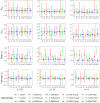Robust and Efficient Assessment of Potency (REAP) as a quantitative tool for dose-response curve estimation
- PMID: 35921131
- PMCID: PMC9348845
- DOI: 10.7554/eLife.78634
Robust and Efficient Assessment of Potency (REAP) as a quantitative tool for dose-response curve estimation
Abstract
The median-effect equation has been widely used to describe the dose-response relationship and identify compounds that activate or inhibit specific disease targets in contemporary drug discovery. However, the experimental data often contain extreme responses, which may significantly impair the estimation accuracy and impede valid quantitative assessment in the standard estimation procedure. To improve the quantitative estimation of the dose-response relationship, we introduce a novel approach based on robust beta regression. Substantive simulation studies under various scenarios demonstrate solid evidence that the proposed approach consistently provides robust estimation for the median-effect equation, particularly when there are extreme outcome observations. Moreover, simulation studies illustrate that the proposed approach also provides a narrower confidence interval, suggesting a higher power in statistical testing. Finally, to efficiently and conveniently perform common lab data analyses, we develop a freely accessible web-based analytic tool to facilitate the quantitative implementation of the proposed approach for the scientific community.
Keywords: Shiny; cancer biology; dose-response; drug potency; none; quantitative tool; robust estimation; software.
Plain language summary
Finding a new drug which is both safe and efficient is an expensive and time-consuming endeavour. In particular, establishing the ‘dose-effect relationship’ – how beneficial a drug is at different dosages – can be challenging. Predicting this curve requires gathering experimental data by exposing and recording how cells respond to various levels of the drug. However, extreme values are often observed at low and high dosages, potentially introducing errors that are hard to correct in the prediction process. Yet, these extreme observations are sometimes genuine so researchers cannot just ignore them. To improve dose-effect estimation, Zhou, Liu, Fang et al. developed a new general-purpose approach. It uses advanced statistical modelling to account for extremes in lab data. This strategy outperformed other methods when dealing with these observations while also providing higher efficiency in data analysis with more uniform data in experiments. To facilitate implementation, Zhou, Liu, Fang et al. set up a user-friendly tool baptized ‘REAP’; this free online resource allows scientists without advanced statistical experience to harness the new approach and to perform dose-effect analysis more easily and accurately. This could boost research across many different disciplines that examine the effects of chemicals on cells.
© 2022, Zhou, Liu, Fang et al.
Conflict of interest statement
SZ, XL, XF, VC, MW, HW, ND, CS, JL No competing interests declared
Figures







References
-
- Bickel P, Doksum K. Mathematical Statistics: Basic Ideas and Selected Topics. Chapman and Hall/CRC; 2015.
-
- Blaauboer BJ, Boekelheide K, Clewell HJ, Daneshian M, Dingemans MML, Goldberg AM, Heneweer M, Jaworska J, Kramer NI, Leist M, Seibert H, Testai E, Vandebriel RJ, Yager JD, Zurlo J. The use of biomarkers of toxicity for integrating in vitro hazard estimates into risk assessment for humans. ALTEX. 2012;29:411–425. doi: 10.14573/altex.2012.4.411. - DOI - PubMed
-
- Byrne HJ, Maher MA. Numerically modelling time and dose dependent cytotoxicity. Computational Toxicology. 2019;12:100090. doi: 10.1016/j.comtox.2019.100090. - DOI
Publication types
MeSH terms
Grants and funding
LinkOut - more resources
Full Text Sources
Miscellaneous

